It’s natural for dog owners to want to share their favorite human foods with their beloved canine companions, often believing that if it’s safe for us, it must be acceptable for them. However, this assumption can be dangerous, as dogs digest foods very differently from humans. What might be a nutritious treat for you could be unhealthy or even deadly for your dog. Understanding What Vegetables Are Not Safe For Dogs – alongside fruits and other human snacks – is crucial for their long-term health and well-being. Accidental ingestion of toxic foods can lead to immediate gastrointestinal distress, chronic health issues, and in severe cases, be life-threatening.
While dogs are often considered omnivores, capable of digesting a varied diet, their systems are uniquely sensitive to certain compounds found in common produce. Incorporating dog-safe fruits and vegetables into their diet, in moderation, can offer beneficial vitamins, minerals, and fiber, serving as a healthy alternative to processed treats. However, the critical distinction lies in knowing which items fall into the “safe” category and which are definitively unsafe. This comprehensive guide will walk you through both dog-friendly produce options and, more importantly, highlight what vegetables are not safe for dogs, empowering you to make informed decisions for your furry friend’s diet. For a broader understanding of what foods dogs can eat, consider exploring additional resources on safe canine nutrition.
Understanding Your Dog’s Dietary Needs: More Than Just Meat
Dogs have evolved over millennia, and while their wild ancestors were primarily carnivores, modern domestic dogs have developed a more omnivorous diet. Their digestive systems can process a variety of foods, including some plant matter, to extract nutrients. However, this doesn’t mean all fruits and vegetables are beneficial or even safe. The difference lies in specific compounds, sugars, and fiber content that can either support canine health or cause significant harm.
Many dog owners find themselves wondering if sharing a piece of their snack is okay. It’s a loving gesture, but one that requires knowledge. For example, while some vegetables offer hydration and essential nutrients, others contain toxins that can be detrimental even in small amounts. Always prioritize your dog’s health by researching or consulting your veterinarian before introducing any new human food into their diet. If your dog is a picky eater, introducing novel, safe options cautiously can sometimes stimulate their appetite.
Fruits Dogs Can Safely Eat (In Moderation)
Many fruits can be a delicious and healthy addition to your dog’s diet when given as occasional treats. They provide valuable vitamins, minerals, and antioxidants. Remember to always wash fruits thoroughly, remove any pits, seeds, or tough rinds, and cut them into bite-sized pieces to prevent choking.
Apples
Apples are a fantastic source of vitamins A and C, and fiber, making them an excellent snack for dogs. Their low protein and fat content also makes them an ideal treat for senior dogs who might benefit from lighter options. Always remove the seeds and core, as apple seeds contain small amounts of cyanide. Freezing apple slices can provide a refreshing, crunchy treat on a hot day.
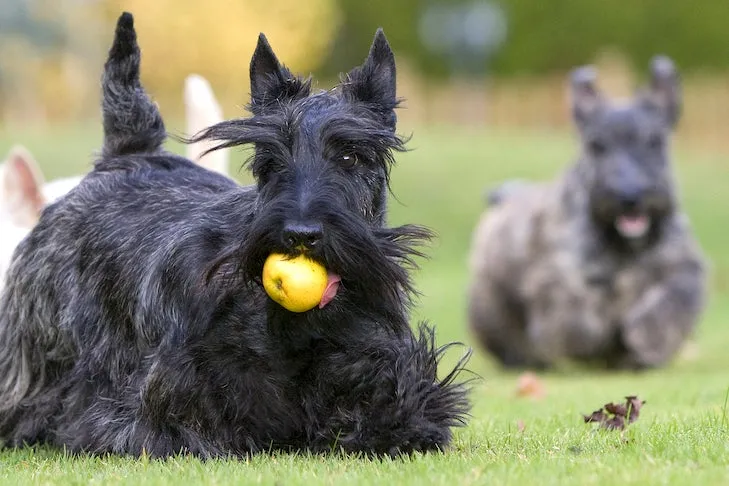 Scottish Terriers playing in the grass.
Scottish Terriers playing in the grass.
Bananas
Bananas are a great low-calorie option for dogs when offered in moderation. They are rich in potassium, vitamins, biotin, fiber, and copper, and are low in cholesterol and sodium. However, due to their high sugar content, bananas should be given sparingly as a treat rather than a regular part of their main diet. A few slices or a mashed portion can be a delightful, healthy snack.
Blueberries
Often called a “superfood,” blueberries are packed with antioxidants that help combat cell damage in both humans and canines. They also provide a good source of fiber and phytochemicals. Their small size makes them an excellent training treat or a fun snack for dogs to catch in the air. Many commercial dog treats also feature blueberries as a beneficial ingredient.
Cantaloupe
Cantaloupe is nutrient-dense, low in calories, and an excellent source of water and fiber. Its hydrating properties can be especially beneficial. However, like bananas, it has a high sugar content, so it should be given in moderation, particularly for dogs who are overweight or have diabetes. Freezing small cubes of cantaloupe can create a wonderful summertime enrichment snack.
Cranberries
Both fresh and dried cranberries are safe for dogs in small quantities. While some dogs might find their tartness unappealing, they offer antioxidants. It’s crucial to feed them in moderation, as too many cranberries can lead to an upset stomach. When choosing dried cranberries, opt for unsweetened varieties, as human-grade sweetened versions contain unnecessary added sugars.
Cucumbers
Cucumbers are particularly beneficial for overweight dogs due to their extremely low carbohydrate and fat content, combined with high hydration. They are loaded with vitamins K, C, and B1, as well as potassium, copper, magnesium, and biotin. Slices of cool cucumber are a refreshing treat, especially in warm weather, and can even be frozen for a fun, hydrating snack.
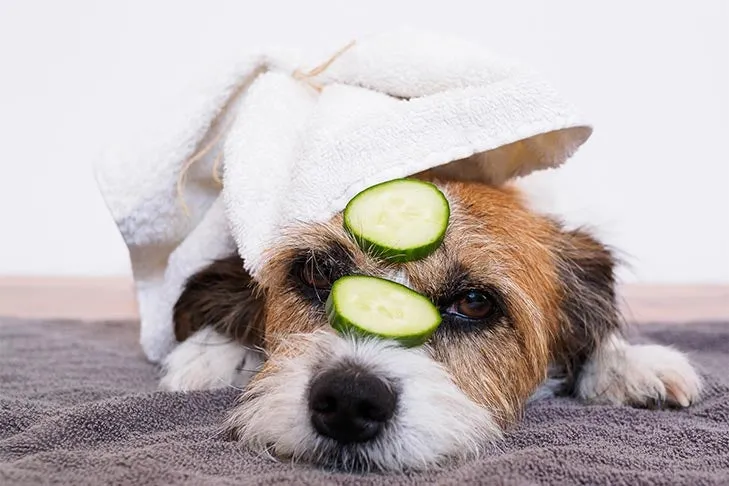 Dog cucumber
Dog cucumber
Mango
This sweet, juicy tropical fruit is a powerhouse of vitamins A, B6, C, and E, along with potassium, beta-carotene, and alpha-carotene. As with many fruits, the hard pit must be removed entirely before serving, as it contains small amounts of cyanide and poses a significant choking hazard. Due to its high sugar content, mango should be an occasional treat, particularly for dogs managing their weight.
Oranges
Veterinarians generally agree that oranges are safe for dogs to eat, though many dogs may naturally shy away from their strong citrus aroma and taste. Oranges are an excellent source of vitamin C, potassium, and fiber. If your dog enjoys them, offer small quantities of the juicy flesh, making sure to remove the peel and any seeds. The peel can be tough on their digestive systems, and the oils might upset their sensitive noses.
Peaches
Fresh or frozen peaches, when cut into small amounts, offer fiber and vitamin A. Similar to cherries, peach pits contain cyanide and must be completely removed and safely discarded to prevent accidental ingestion. Avoid canned peaches, which are often packed in sugary syrups and contain more sugar than any dog needs. Frozen peach slices can be a great summer enrichment snack.
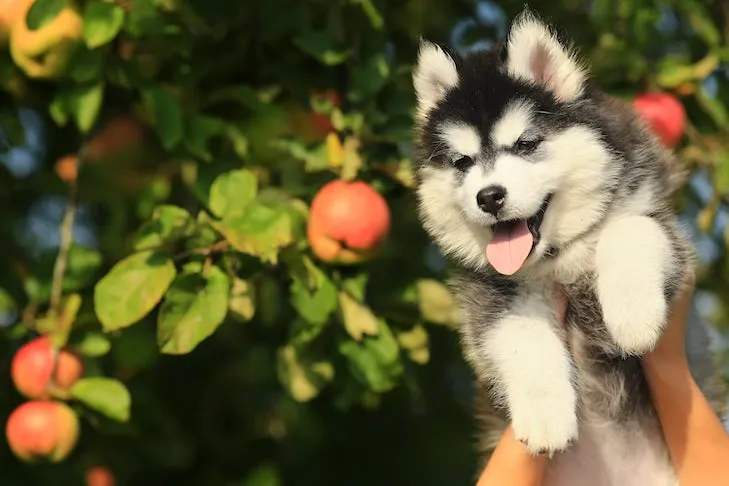 Siberian Husky puppy being held up in front of an apple tree.
Siberian Husky puppy being held up in front of an apple tree.
Pears
Pears are a good snack choice, rich in copper, vitamins C and K, and fiber. When sharing pears, always cut the flesh into bite-sized pieces and remove the pit and seeds, as they contain traces of cyanide. As with other fruits, steer clear of canned or jarred pears that come in sugary syrups.
Pineapple
A few chunks of fresh pineapple can be a sweet and healthy treat for dogs, provided the spiky outer peel and crown are removed. This tropical fruit is full of vitamins, minerals, and fiber. It also contains bromelain, an enzyme believed to aid protein absorption. Always avoid canned or packaged pineapple in sweetened syrups due to the unnecessary added sugars.
Pumpkin
Pure pumpkin is a highly beneficial food for dogs, revered for its digestive health properties. It’s packed with antioxidants and is especially effective at relieving both diarrhea and constipation. When buying canned pumpkin, ensure it’s 100% pumpkin puree, not pumpkin pie filling, which contains spices and sugar. Alternatively, you can roast pumpkin in the oven and feed the peeled flesh to your dog.
Raspberries
Raspberries are safe for dogs in moderation and are rich in beneficial antioxidants. They are low in sugar and calories but high in fiber, manganese, and vitamin C. Raspberries are particularly good for senior dogs, as their anti-inflammatory properties can support aging joints. However, raspberries contain small, naturally occurring amounts of xylitol, so limit your dog’s intake to no more than eight ounces of fresh or frozen raspberries to be safe.
Strawberries
Strawberries are a good source of fiber and vitamin C and contain an enzyme that may even help whiten your dog’s teeth. Like all fruits, they contain natural sugars, so moderation is key. Frozen strawberries can provide a fun and engaging enrichment treat.
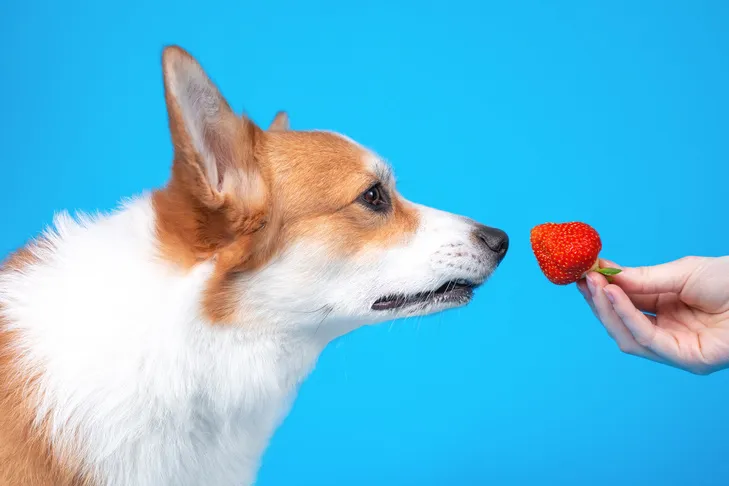 Pembroke Welsh Corgi and strawberry
Pembroke Welsh Corgi and strawberry
Watermelon
Dogs can enjoy watermelon, but it’s critical to remove all seeds and the rind beforehand, as these can cause intestinal blockages. The flesh of watermelon is safe and boasts vitamins A, B-6, and C, as well as potassium. Comprising 92% water, it’s an excellent way to help keep your dog hydrated during hot weather. Freezing seeded watermelon chunks makes for a wonderful, cooling enrichment treat.
Fruits Dogs Should Strictly Avoid
While many fruits are healthy for humans, some contain compounds, seeds, or parts that are dangerous, if not toxic, to dogs. It is best to keep these fruits out of your dog’s reach to ensure their safety. Understanding specific fruits that are not allowed for dogs is paramount for preventing emergencies.
Avocado
Although avocado is a healthy fat for humans, it should not be given to dogs. The pit, skin, and leaves of avocados contain persin, a toxin known to cause vomiting and diarrhea in dogs. While the fleshy inside of the avocado fruit has less persin, it can still be too much for a dog’s system to handle. Furthermore, avocado flesh is high in fat, which can lead to gastrointestinal upset or contribute to health conditions like pancreatitis if consumed in large quantities.
Cherries
With the exception of the fleshy fruit around the seed, cherry plants, including the stems, leaves, and particularly the pits, contain cyanide. Cyanide poisoning in dogs disrupts cellular oxygen transport, meaning their blood cells cannot adequately deliver oxygen throughout the body. If you have a cherry tree, ensure your dog doesn’t have access to fallen fruit. Signs of cyanide poisoning include dilated pupils, difficulty breathing, and bright red gums, all of which constitute a veterinary emergency. Always dispose of cherry pits in a dog-proof trash receptacle.
Grapes
Grapes and raisins are highly toxic to dogs, regardless of breed, sex, or age. Ingestion can lead to acute sudden kidney failure, a life-threatening condition. Even a small amount can be dangerous. It is imperative to keep grapes and raisins completely out of your dog’s reach, especially if children are consuming them in the household. Never include them in a compost pile accessible to your dog, and ensure your trash cans are dog-proof.
Tomatoes
While the ripened red flesh of a tomato fruit is generally considered safe for dogs, the green parts of the tomato plant—including the leaves, stems, and unripe green tomatoes—contain a toxic substance called solanine. A dog would need to ingest a significant amount of the plant material to become severely ill, but it’s always safer to avoid feeding tomatoes altogether. If your dog enjoys exploring your garden, prevent them from accessing tomato plants.
 Rottweiler laying down in the yard, its head tilted.
Rottweiler laying down in the yard, its head tilted.
Vegetables Dogs Can Safely Eat (For Health and Fun)
Knowing which vegetables are safe for your dog is just as important as knowing which aren’t. Many vegetables offer fantastic nutritional benefits and can be confidently shared with your canine companion as healthy treats.
Broccoli
Broccoli can be safe for dogs in small amounts and is best served as an occasional treat. It’s high in fiber and vitamin C and low in fat. However, broccoli florets contain isothiocyanates, which can cause mild to potentially severe gastric irritation in some dogs if consumed in large quantities. The tough stalks are also a potential obstruction hazard in the esophagus. To minimize these risks, it’s better to offer cooked broccoli in very small, manageable pieces.
Brussels Sprouts
Brussels sprouts are packed with beneficial nutrients and antioxidants for both humans and dogs. However, moderation is key when feeding them to your dog, as overfeeding can lead to excessive gas and digestive discomfort. If your dog enjoys them and tolerates them well, they can be a nutritious, occasional addition to their diet.
Carrots
Carrots are an excellent, low-calorie snack that is high in fiber and beta-carotene, which the body converts into vitamin A. Beyond their nutritional value, the crunchiness of carrots can also help clean your dog’s teeth. Carrots are a common ingredient in many commercial dog foods and treats, highlighting their recognized benefits for canine health.
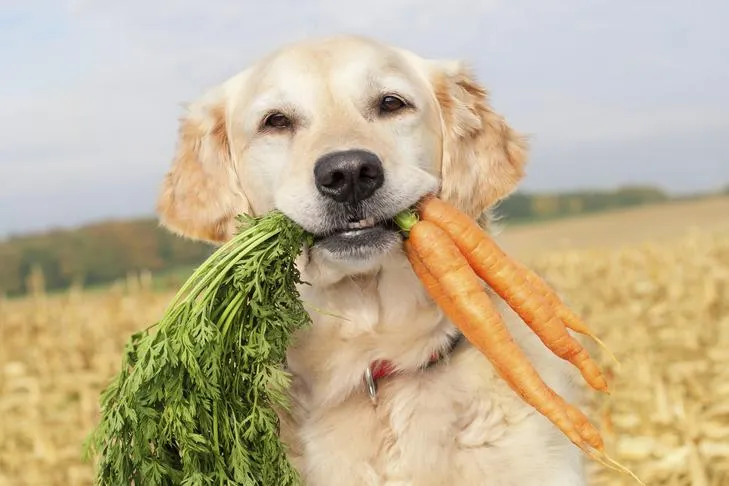 Golden Retriever holding carrots.
Golden Retriever holding carrots.
Celery
Celery offers a range of vitamins (A, B, and C) and other nutrients beneficial for promoting a healthy heart and potentially fighting cancer. An added bonus is its reputation for freshening doggy breath! Cut into small, manageable pieces, celery can be a crunchy, hydrating, and nutritious treat.
Green Beans
Green beans, whether chopped, steamed, raw, or canned (plain, without added salt), are safe for dogs to eat. They are rich in important vitamins and minerals, high in fiber, and low in calories, making them an excellent healthy snack or a supplement to a dog’s meal. For canned varieties, always opt for “no-salt-added” versions. Frozen green beans can also be a fun, frosty treat.
Peas
Green peas, snow peas, sugar snap peas, and garden or English peas are all generally safe for dogs when given occasionally. Peas contain several vitamins, minerals, and are rich in protein and high in fiber. You can feed your dog fresh or frozen peas, but avoid canned peas due to their high sodium content.
Spinach
Dogs can technically eat spinach, but it’s not the top recommendation among safe vegetables. Spinach contains oxalic acid, which can interfere with the body’s ability to absorb calcium and, in very large quantities, potentially lead to kidney damage. While a dog would likely need to consume a substantial amount of spinach for this to be a serious issue, many experts suggest opting for other, more beneficial vegetables.
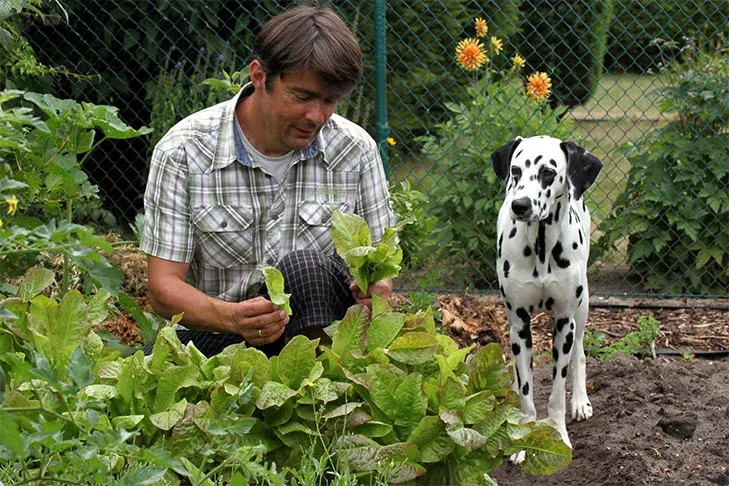 Dalmatian watching a man gardening and picking leaves.
Dalmatian watching a man gardening and picking leaves.
What Vegetables Are Not Safe for Dogs? Avoid These At All Costs
It’s absolutely essential for every dog owner to be well-informed about what vegetables are not safe for dogs. While a wide variety of vegetables offer health benefits, some are toxic or can cause significant harm. This section focuses on the vegetables that should never make their way into your dog’s bowl.
Asparagus
While asparagus is not inherently toxic to dogs, it offers very little benefit and isn’t typically recommended. It’s too tough to be eaten raw, and by the time it’s cooked down to a soft, digestible texture, most of its nutritional value is lost. Given the many other truly beneficial and palatable vegetables available, there’s simply no compelling reason to include asparagus in your dog’s diet. If you’re looking for healthy vegetable alternatives, explore what you can give your dog to encourage eating other safe options.
Mushrooms
Wild mushrooms pose a significant threat to dogs and should always be avoided. Of the approximately 50,000 mushroom species worldwide, 50 to 100 are known to be toxic. These poisonous varieties can cause severe illness, organ damage, or even death. Identifying safe wild mushrooms is extremely difficult, even for experienced foragers, so the safest approach is to consider all wild mushrooms potentially lethal.
On the other hand, thoroughly washed mushrooms purchased from a supermarket for human consumption are generally considered safe for dogs in small, cooked amounts. However, due to the high risk associated with wild mushrooms and the limited nutritional benefits of store-bought ones, many veterinarians advise against feeding mushrooms to dogs entirely. When exploring options for a dog with specific health concerns, such as dogs with pancreatitis, it’s crucial to consult a vet and stick to clearly safe foods.
Onions (and other Allium plants)
Dogs should absolutely never eat onions. Onions, along with leeks, chives, garlic, and shallots, belong to the Allium family of plants, which are highly poisonous to most pets, particularly dogs and cats. The toxic compounds in Allium plants can cause oxidative damage to a dog’s red blood cells, leading to a condition called hemolytic anemia, where red blood cells rupture.
Symptoms of onion poisoning can include:
- Vomiting
- Diarrhea
- Stomach pain
- Nausea
- Lethargy
- Pale gums
- Elevated heart rate
- Weakness
- Collapse
The severity of the poisoning can depend on the amount consumed relative to the dog’s body weight, but even small, repeated exposures can lead to problems. Japanese breeds of dogs, such as Akitas and Shiba Inus, are known to be particularly susceptible to onion toxicity, but all dogs are at risk. It’s crucial to be vigilant, especially if children are present in the household and might inadvertently share food containing onions. Always secure leftovers and ensure trash bins are inaccessible to your dog.
General Safety Tips for Feeding Produce to Dogs
When introducing any fruit or vegetable to your dog’s diet, even those considered safe, always follow these guidelines:
- Moderation is Key: Treats should never make up more than 10% of your dog’s daily caloric intake. Overfeeding, even healthy produce, can lead to an upset stomach or an imbalanced diet.
- Proper Preparation: Always wash produce thoroughly to remove pesticides and dirt. Remove all seeds, pits, stems, and tough rinds that can be choking hazards or contain toxic compounds. Cut fruits and vegetables into small, digestible pieces appropriate for your dog’s size.
- Introduce Slowly: Introduce new foods one at a time and in very small quantities. Monitor your dog for any signs of digestive upset (vomiting, diarrhea, gas) or allergic reactions.
- Avoid Added Ingredients: Never feed canned fruits with added syrups or vegetables with added salt, butter, or spices. Stick to plain, fresh, or frozen produce.
- Consult Your Vet: If you have any doubts about a specific food or if your dog has underlying health conditions (like diabetes or pancreatitis), always consult your veterinarian before making changes to their diet. They can provide personalized advice based on your dog’s individual needs.
- Emergency Preparedness: Know the signs of food poisoning and have your veterinarian’s contact information readily available, along with the number for a pet poison control center.
Conclusion
Navigating the world of human foods for dogs can be complex, but armed with the right knowledge, you can safely enrich your canine companion’s diet. While many fruits and vegetables offer excellent nutritional benefits when given in moderation and prepared correctly, it is critically important to understand what vegetables are not safe for dogs – and the same goes for fruits. The dangers posed by foods like onions, grapes, avocado, and wild mushrooms are severe and can lead to serious health emergencies.
Always prioritize your dog’s safety by sticking to veterinarian-approved foods, being meticulous about preparation, and exercising caution with any new additions to their diet. When in doubt, it’s always best to err on the side of caution and consult your vet. By being informed and responsible, you can ensure your furry family member enjoys a healthy and happy life, free from preventable food-related hazards. Remember, a healthy treat should always contribute positively to your dog’s well-being.
